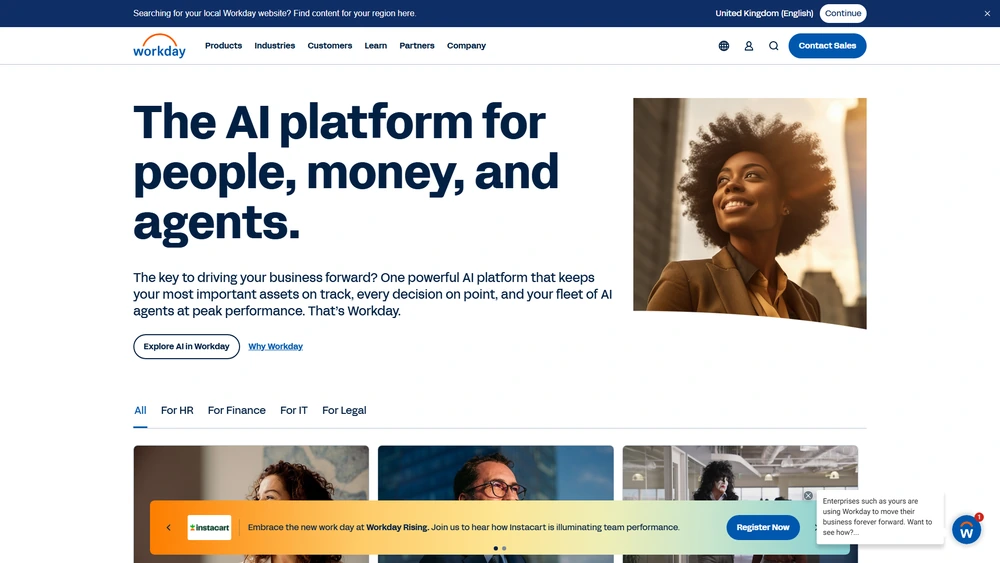Workday Overview & 2025 Industry Position
Founded on the vision of simplifying enterprise software, Workday has become a powerhouse in Human Capital Management (HCM) and Finance systems. As of 2025, it continues to play a central role in helping organizations unify HR, payroll, finance, and planning operations into one cloud-native platform. With robust tools for talent acquisition, workforce analytics, and financial forecasting, Workday offers critical competitive advantages in a digital-first, compliance-heavy enterprise environment.
In 2025, Workday firmly anchors its roadmap in three core priorities: enhancing AI/ML functionality, supporting hybrid workforce agility, and reinforcing regulatory readiness—particularly in global payroll and workforce oversight.
From Launch to 2025: Workday’s Journey
Workday was founded in 2005 by Dave Duffield and Aneel Bhusri, former leaders at PeopleSoft. The project launched with the goal to modernize enterprise applications through a cloud-only, software-as-a-service (SaaS) model. Milestones include:
- 2006: First customer goes live on Workday HCM
- 2012: IPO raises $637M, cementing enterprise trust
- 2015: Launch of Workday Financial Management
- 2018: Introduction of Workday Learning and Talent Optimization
- 2021: Acquisition of VNDLY to bolster workforce scalability
- 2023: Workday Skills Cloud AI enhancements announced
In 2025, Workday’s strategy is clear: empower global organizations to make faster, smarter decisions by unifying the data, tools, and workflows of HCM and finance inside a single platform powered by next-gen AI.

Workday Key Features
Workday’s broad functionality makes it a one-stop platform for HR, payroll, planning, and finance. Key 2025 features include:
- Workday Human Capital Management (HCM): Manage full employee lifecycle from recruitment to retirement.
- Workday Financial Management: Unified general ledger, accounts, and real-time reporting in one system.
- Workday Adaptive Planning: Enterprise planning and budgeting collaboration for finance and HR.
- Skills Cloud AI: Uses machine learning to normalize and analyze workforce capabilities.
- Workday Peakon Employee Voice: Continuous engagement and feedback platform with pulse surveying.
- VNDLY Integration: Seamless contractor and external workforce management.
Workflow & UX Highlights
Workday’s redesigned 2025 interface prioritizes streamlined navigation, mobile responsiveness, and customizable dashboards. UI elements emphasize clarity and accessibility across device types. Users can configure cards, auto-sync calendars, and set workflow triggers with minimal training.
Key UX strengths include:
- Widget-based home dashboard for role-specific access
- Consolidated search with AI-predictive prompts
- Integrated mobile approvals and document review
- Consistent functionality across iOS, Android, and web
Workday Pricing Analysis & Value Metrics
Workday pricing varies based on enterprise size, product modules, and deployment complexity. As of July 2025, here’s a representative snapshot:
| Plan | Includes | Pricing |
|---|---|---|
| Core HCM | Employee records, onboarding, payroll integration | Starting at $50/user/month |
| HCM + Financials | All core HCM plus general ledger, spend mgmt | Custom quote; est. $80–110/user/month |
| Workday Adaptive | Enterprise planning & budgeting tools | $35/user/month (add-on) |
| Peakon Add-on | Employee sentiment & feedback platform | $4–6/user/month |
Value Note: Workday is cost-justified for midmarket and enterprise clients seeking long-term ROI from end-to-end HCM-finance integration, reduced IT overhead, and enhanced compliance.
Competitive Landscape
2025’s top competitors in the enterprise HCM-finance space include:
| Platform | Strengths | Limitations |
|---|---|---|
| Oracle Cloud HCM | Deep enterprise integrations across ERP | Complex UI, heavy IT dependency |
| SAP SuccessFactors | Global compliance rigor, depth in L&D | Piecemeal modules, cost creep |
| Rippling | Streamlined SMB HR & finance on one stack | Not suitable for large enterprises |
| UKG Pro | Strong US payroll & compliance | Weaker planning & forecasting tools |
Use Cases by Industry & Size
- Mid-Sized Technology Firms: Rapid onboarding, remote payroll, and goal tracking in one interface.
- Global Manufacturers: Gain unified real-time P&L visibility and multi-regional compliance support.
- Healthcare Organizations: Staff credential tracking, labor planning, compliance audits.
- Higher Education: Role-based access, research fund tracking, academic appointments, and grants.
Workday Integrations & Ecosystem
Workday integrates with nearly 600 third-party systems through Workday Extend and community connectors.
- CRM: Salesforce, Zoho, Microsoft Dynamics
- Payroll: ADP, Gusto, Ceridian Dayforce
- Accounting: QuickBooks, NetSuite, Sage Intacct
- E-commerce & SaaS: Shopify, Coupa, Okta
These integrations empower companies to automate full HR-to-finance flows without compromise.
Pros & Cons
- ✔ Unified solution for large HR and finance teams
- ✔ Exceptional scalability with flexible modules
- ✔ AI-powered analytics improve decision-making
- ✖ Steep learning curve for smaller HR teams
- ✖ Premium pricing limits accessibility for SMBs
- ✖ Implementation often requires a certified partner
Pro Tip: Make the most of Workday Adaptive Planning by integrating it early in your implementation roadmap—it accelerates ROI for finance and HR alignment.
Final Thoughts
Workday shines for mid-to-large enterprises seeking end-to-end visibility across HR and finance under one intelligent, adaptive ecosystem. While overpowered for lean SMBs, its modular expansion paths, automation potential, and global compliance capabilities make it indispensable for organizations undergoing digital transformation at scale. Those prioritizing future-readiness, workforce data insights, and operational transparency will find Workday to be a compelling strategic partner.
Workday FAQ
No, but it’s best suited for midmarket and enterprise firms. Smaller businesses may find it over-featured relative to their needs and budgets.
Workday is particularly strong in healthcare, financial services, higher education, manufacturing, and tech-driven enterprises.
Yes. Workday provides tiered support levels via live chat, email, and dedicated account managers for enterprise clients and partners.
Implementation varies by complexity but typically ranges from 3 to 9 months, depending on chosen modules and size.
Yes. Workday offers integration connectors for both platforms as well as an open API for custom integrations.